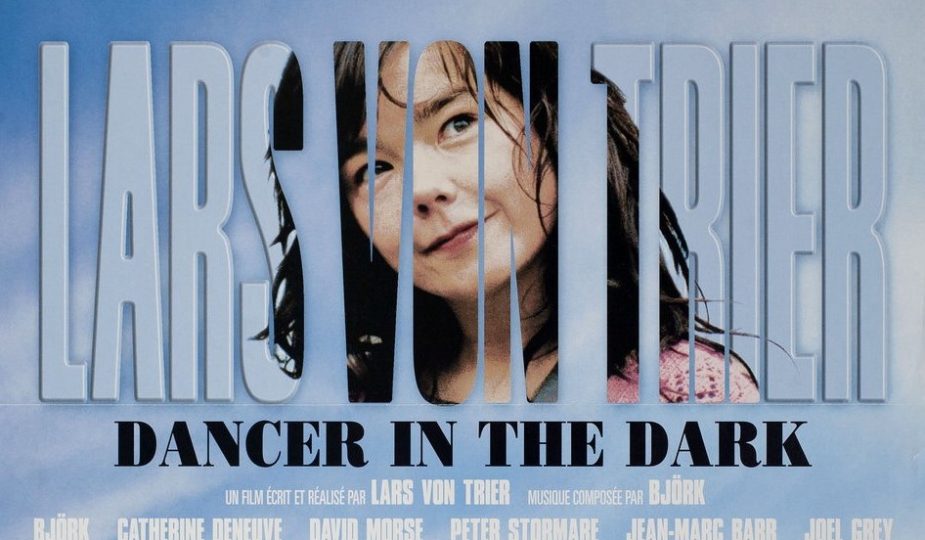
Dancer In The Dark (2000)
Director: Lars von Trier
Currently, Lars von Trier is one of the most controversial filmmakers. He has been exiled from the Cannes Film Festival, denounced for sexual harassment and racism, and has been highly criticized and declared as mentally ill due to the themes of his films. At the same time, Von Trier is considered to be one of the greatest filmmakers of contemporary cinema.
He was born in Copenhagen, Denmark, on April 30, 1956. His original name was Lars Trier. Although his biological father’s name was Hartmann, Lars took the last name of Ulf Trier (of whom he thought to be his father until 1989). He added the “von” to his name later, when he was a 25-year old student at the National Film School of Denmark, influenced by the directors Erich von Stroheim and Josef von Sternberg.
His parents were Inger Høst and Ulf Trier, she was a leftist progressive and he was a social democrat. He was educated as an atheist and once declared that there was no place for “feelings, religion, or fun” in their house. In 1989 it was revealed to him that his real father was the German Fritz Michael Hartmann, Minister of Social Affairs of the Danish government. His mother confessed on her last days that she had decided to get pregnant with Hartmann because of the artistic genes that Lars would inherit. Hartmann came from a family of classical musicians: Emil Hartmann, J. P. E. Hartmann, Niels Gade, Johan Ernst Hartmann and Niels Viggo Bentzon.
This revelation caused a gigantic sadness and emptiness in the already introverted Lars, this event was the impulse of anger that led him to forge his hard and powerful personality.
The same year he added the “von” to his last name, he received two awards at the International Festival of Film Schools in Munich for his pieces Nocturne (1980) and Last Detail (1980). He also studied film theory at the University of Copenhagen and he made the half-length film Image of Relief (1982), which won the award for best film at the 83rd Munich Film Festival and became the first University production made in Denmark that reached theaters.
Lars von Trier was 27 years old and had his place in the film circuit. His degree project had been presented at the two biggest festivals in Germany (they also screened it at the 34th edition of the Berlin International Film Festival in the ‘Panorama’ section) and the critics said that it was a very well executed product that explored a morbid theme, placed in the perspective of an unusual character. Provocative from his first works, Von Trier started to make his own way into his dark and legendary career.
He is one of the central figures of the Dogma 95, which was an avantgarde film movement, announced on March 13, 1995. The goal of Dogma 95 was to “purify cinema”, rejecting the expensive special effects, modifications and post-production editions, this filmmakers seek to get rid of all falsehood contained in Hollywood films, in order to project something as close as possible to reality: something real and raw.
This central objective is masterfully discerned in the film Dancer In The Dark (2000): Lars von Trier used a digital format, very little props and mute colors to focus specifically on the performances and the plot. This fascinating musical drama has a very special leading role: the Icelandic singer and songwriter Björk.
The name and prestige of von Trier at that time, made actors like Catherine Deneuve, David Morse, Stellan Skarsgård, Udo Kier and Joel Gray star in the film. But the protagonism of the entire film is for Björk, who plays the character of Selma Jezkova, a Czech immigrant who arrives in the United States in 1964, in the company of her son Gene (Vladica Kostic).
Selma suffers from a degenerative hereditary disease that causes rapid progressive blindness. For this reason, she works hard in a factory, in the company of her friend Kathy (Catherine Deneuve), whom Selma nicknames “Cvalda”. Selma saves all the money she earns to pay an eye operation to her son, so that he does not suffer the same fate as her.
One of the few pleasures for Selma, besides her son, are American musicals, and so she begins to participate in a play called “The Sound of Music”. In addition, Selma always accompanies her friend Kathy to the local cinema, where they watch fabulous Old-Hollywood musicals together. As soon as Selma starts going blind, she begins to have hallucinations and delusions in which she feels that she lives inside a musical. She escapes from her reality for brief minutes and amplifies her mood through music.
The film has the look of a documentary being made with hand-held cameras. Being a film that respects the “Dogma 95”, we feel as more than spectators: we are absolute participants in the most private and vulnerable moments of all the characters, especially Selma. When there is no music or camera movements that distract us, the center of attention is the constant emotion,and even the smallest gestures have a meaning. Intimate smiles and devastating moments are amplified thanks to the peculiar style of the film.
Björk wrote the music of all the songs in the film, in collaboration with her habitual lyricist Sjón Sigurosson and Lars von Trier. One of the songs in the film, titled “I’ve seen it all”, is a special collaboration with Radiohead’s frontman, Thom Yorke. The song has one of the most beautiful lyrics and melodies ever heard. Alexandra Flood of MTV said about the song: “The centerpiece of the soundtrack is”, “I’ve Seen It All”, her duet with Radiohead’s Thom Yorke, Björk describes the song as Selma’s manifesto, it’s a beautiful and eerie track, the pair’s vocals careening over a techno beat, but just under a lovely set of strings. It’s a minor masterpiece.”
Although the palette of colors in the film is composed of dark brown and gray tones, the sequences that take place in Selma’s mind take us to a totally different and more colorful world: the world of her imagination, where colors shine or vibrate together with a much more complete sound, making us get involved in her extraordinary fantasy world.
The performance of Björk in this film is extremely incredible, it is definitely my favorite female performance of all times. She gives us an interpretation that is emotionally naked, heartbreaking and raw, but at the same time full of joy and hope. Björk projects a complex mixture of youthful vulnerability and maternal determination. The film, despite winning the Palme d’Or at the Cannes Film Festival (for Best Film and Best Actress for Björk), as well as several European Film Awards, was very controversial at the time, dividing the viewers and critics into two irreconcilable groups- those who adored it and those who simply could not stand it.
Like many of his female leads, Björk confessed that she had serious problems with Lars von Trier and blamed him of sexual abuse in the #metoo era. Despite all the awards received, she did not want to act in any other film, due to the enormous emotional tension experienced in her role, which reached the limits of being completely disturbing. The scenes where Selma is disconnected from reality through music are masterful, you can feel the sweetness and innocence of how she perceives life. Few performances in the cinema left me so astonished and fascinated. As I write this article, I remember some scenes, and the anguish takes over my soul.
We feel the premonition of fatality. An indefinable fear takes hold of the mood until the heart is clenched. Some people dance in the light, it’s easy and simple, but that’s why it’s still pretty. Others dance in the dark, which is very difficult and has much more merit, those are the ones that have beautiful virtues, those are the ones that truly enjoy and comprehend life.
by Octavio Carbajal González

[…] Danish director Lars von Trier not only directed the mother of all over-the-top melodramas with Dancer in the Dark (2000), but also set it up as a Musical in which the insufferable Björk took the lead. Under the […]
Another great review. Thank you Octavio and sorry I was so late to read this
Thank you, Mike !. This comment is highly appreciated. I´m looking forward for your next stories, I really enjoy them a lot, you got a special talent on transmitting meaningful memories !.
As a Björk fan, I always revisit the record “Selma Songs” which was composed for this film. It has an incredibly dose of instrumental beauty, the movie is a little long but I was very pleased with all the result. Thank you, nice review..
I also got that record, it´s great !. I get an instant revival of the musical numbers of the movie. I´m so glad you appreciated my review, thanks Adriana !.
There are so many interesting aspects about his life, thank you for taking the time to dig inside my review, Jann. I think this movie breaks down all conventions that were shaped around musical dramas, this is pure emotional rawness and profoundly crushing cinema.
Fascinating review and biography of (maybe) the most controversial filmmaker, Björk’s performance is huge !
Thank you for taking the time to read, Chris !. You’re very kind. I agree on that, Lars is highly controversial, his last film was pure mental insanity, I loved it but some people absolutely despised it. I think “Melancholia” and “Dogville” are his most audience-friendly movies. “Dancer in the Dark” is also an incredibly divisive movie, it has entered directly on my 10 favorite movies.
I didn’t know that about Lars von Trier, thank. I dislike him but this film is an exception. It’s good
There are so many interesting aspects about his life, thank you for taking the time to dig inside my review, Jann. I think this movie breaks down all conventions that were shaped around musical dramas, this is pure emotional rawness and profoundly crushing cinema.